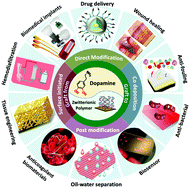Bioinspired dopamine and zwitterionic polymers for non-fouling surface engineering
Abstract
Biofouling is a serious problem in the medical, marine, and all other industrial fields as it poses significant health risks and financial losses. Therefore, there is a great demand for endowing surfaces with antifouling properties to mitigate biofouling. Zwitterionic polymers (containing an equimolar number of homogeneously distributed anionic and cationic groups on the polymer chains) have been used extensively as one of the best antifouling materials for surface modification. Being a superhydrophilic polymer, zwitterionic polymers need a strong binding agent to continue to remain attached to the surface for long-term applications. The use of a mussel-inspired dopamine adhesive functional layer is one of the most widely exploited approaches for the attachment of a zwitterion layer on the surface via thiol and amine chemistry. Based on recent studies, we have categorized this dopamine and zwitterion conjugation into four different approaches: (1) conjugation of dopamine with zwitterions by direct modification of zwitterions with the dopamine functional moiety; (2) co-deposition of dopamine with zwitterionic polymers; (3) zwitterionic post modification of the polydopamine (PDA) coated surface; and (4) surface-initiated polymerization of zwitterionic polymers using dopamine modified initiators. In this review, we have briefly discussed about all the possible conjugation mechanisms and reactions for this promising dopamine and zwitterion conjugation and how this conjugated system significantly contributes to the development of non-fouling surfaces along with the other applications.



 Please wait while we load your content...
Please wait while we load your content...